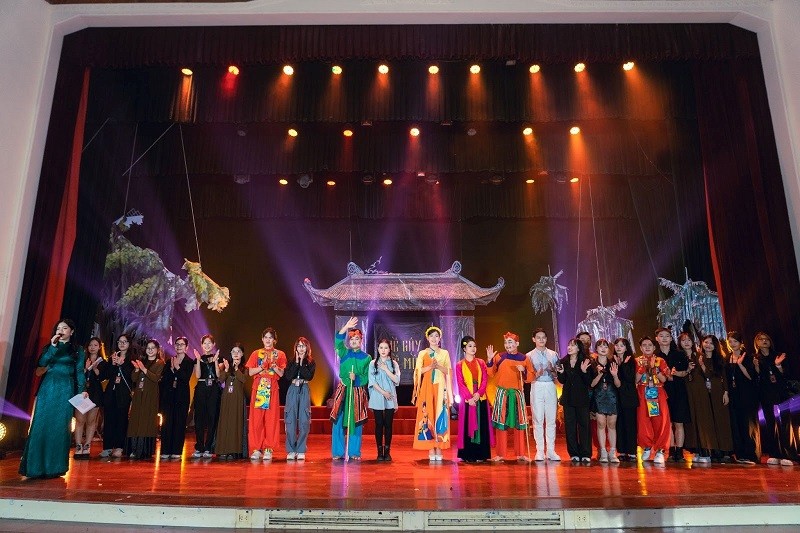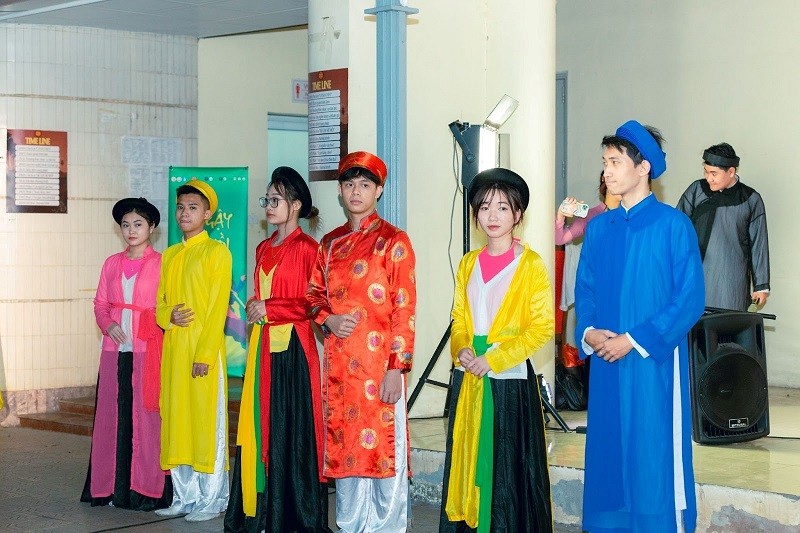
Vietnamese youth rediscover the art of Cheo
Latest
 |
| The "He gay he moi" art program has attracted the participation of numerous artists and students. (Photo: Organizing Committee) |
Recently, students from the Hanoi University of Culture successfully organized the "He gay he moi" art program aimed at deepening audience understanding and experience of the interplay between traditional and modern Cheo.
The event took place at the Cultural House of Hanoi University of Culture, drawing significant interest and participation from the audience, including guests and the presence of many artists.
Discussing the inspiration behind the program, Nhat Linh, Head of Content, stated: "Cheo is a distinctive traditional art form of our nation but is gradually losing its prominence due to modern forms of entertainment.
For this reason, 'He gay he moi' was created. Through this program, we hope to cultivate a love for Cheo among the youth in particular and a passion for the traditional arts of our nation in general."
The first part of the program, titled 'Ganh cheo,' intricately and authentically replicated the quintessential aspects of Northern Vietnamese villages, which are known as the birthplace of Cheo melodies. The setting was meticulously crafted to resemble the traditional gates of a Northern hamlet, the courtyard of a communal house, and other elements of vernacular architecture. Complementing this was a photo exhibition aptly named ‘'Phi he bat thanh Cheo”, loosely translated to “Without the Jester character, there is no Cheo.”
When mentioning traveling Cheo troupes (Ganh cheo), most people think of Cheo neighborhoods (phuong cheo), Cheo bands, or organizations of Cheo performers.
Therefore, the organizers also recreated an ancient Cheo troupe with the interactive play "Mother Dop and the village chief" harmoniously combined with folk music tunes and Cheo costume performances.
After the conclusion of the first part, the audience was invited to the next space with the second part named "He gay he moi," comprising three segments: "Cultural Roots," "Spring in the Village of Cheo," and "The Interplay of Eras."
Here, the program recreated a unique cultural space of Cheo, where there was a smooth interplay between the past and present, between tradition and the new era, through outstanding performances, filled with emotion and more accessible to the younger generation.
Not only showcasing the inspired journey of passionate Gen Z students, but the program also featured a creative collaboration with professional actors from the Vietnam Cheo Theatre and young artists from the Vietnam National Academy of Music.
 |
| Students from Hanoi University of Culture in traditional Cheo costumes. (Photo: Organizing Committee) |
Thus, amidst the plethora of modern art forms, numerous Vietnamese youths remain dedicated to projects that spread the love for national arts.
Many assume that the youth are indifferent to national arts. However, the programs by students of Hanoi University of Culture and the "48-hour Cheo - I Perform Cheo for my Homeland" project have proven otherwise.
This trend indicates that young people are voluntarily and enthusiastically turning towards traditional arts, particularly Cheo, carving out new paths and approaches.
Under the sponsorship of "I'm 20" – a non-profit organization run by students, along with the Center for Research, Preservation, and Promotion of National Music and the Center for Sustainable Development Studies, "48-hour Cheo - I Perform Cheo for my Homeland" has inspired and connected young individuals, especially students, with the unique values and traditional beauty of Vietnamese folk Cheo.
Over nearly a decade, this project has successfully organized more than 20 courses in traditional arts such as Cheo, Xam, Chau van...
More than 60 creative experience programs have also been held, both in-person and online, attracting the participation of over 400,000 students and audience members domestically and internationally, with events like "Roots of Culture"; "Young Culture Day"; "Return to the Source"; "Gala I Perform Cheo for my Homeland"; and the workshop series "Experiencing Intangible Cultural Heritage," "Cheo Dance."
| Cheo is a form of Vietnamese traditional stage art, which strongly develops in the north, especially the Red River delta. It originated in the 10th century from folk music and dance and is popular in areas in the north. Different from other folk-art forms, Cheo is a form of Vietnamese traditional stage art imbued with the national characteristics of a unique combination of singing, dancing, music and drama. Cheo is a singing style which can be solo, a duet or a choir. The melody of Cheo plays is very suitable for the natural voice and language of the Vietnamese people. A Cheo performance requires the artists to have the skills of singing, dancing and performing with background music of drums, mo (wooden tocsin), sao (bamboo flute) and nhi (two double-stringed instruments). The content of the plays often describes the simple life of farmers, herdsmen, craftsmen, and landowners. It praises virtues, criticizes bad habits and vices, fights against injustice and shows love and compassion, tolerance and forgiveness. The dossier for Cheo art of the Red River Delta will be compiled to seek UNESCO recognition as cultural heritage of the world. |

















